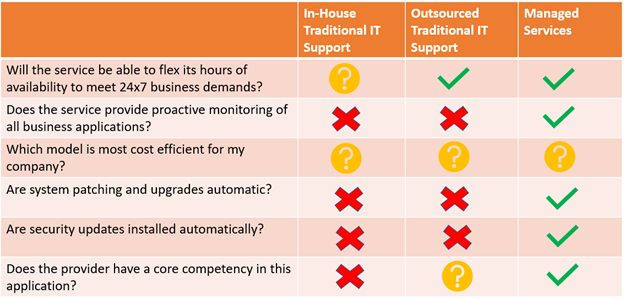Managed Services vs. Traditional IT Support: What's the Difference?


As an IT leader, you may be asking yourself if your IT support services are keeping pace with the demand of your ever-evolving applications landscape. It’s an important question to contemplate and quite honestly should be a part of your regular planning cadence. More and more businesses are shifting their focus to Cloud, Cognitive and AI. They want to cut capital expenditures associated with server farms, have someone else manage updates and improve their disaster recovery capabilities. In addition, cognitive service management and AI provide improved productivity, lower costs, and better accuracy. Ensuring you have the right resources, who are properly trained to provide the right end-user assistance, impacts more than just downtime; it impacts the bottom line, your scalability, and ability to implement new technologies.
Gartner 1defines IT services as “…the application of business and technical expertise to enable organizations in the creation, management and optimization of, or access to, information and business processes.” They also break IT services into segments based on the skills required to deliver the service (e.g., design, build, run, etc.) and the categories of service (i.e., business process services, application services and infrastructure services). So, let’s look at both traditional IT support services and managed services, break down the key differences, and help guide you in your decision-making process of which best fits your company’s circumstances.
When we talk about traditional IT support and managed services (MS), it’s important to understand the basic differences. Let’s start with traditional IT support. This type of support is most commonly known as “break-fix” support and is usually depicted that way due to the reactive nature of the process. Something isn’t working right so the user notifies the help desk and waits for the problem to be fixed. This could mean waiting until the IT support group is back in the office if they offer services only during standard business hours.
Traditional IT support can be offered in-house or be outsourced. The in-house model is often used by smaller businesses who don’t want or need to invest in an outsourced model, but in-house support can also be found in medium to larger businesses. These businesses usually aren’t technical in nature and don’t rely heavily on their IT infrastructure to be fully available 24x7.
Traditional IT support solves many problems. If your business is not growing in complexity, a traditional IT support model may be a good choice. It may also be a good choice if you have a complex, customized application base that is not subject to frequent upgrades; or if your applications don’t require specialized skillsets and regular training to maintain.
Managed Services are services provided by a third party to perform the care and feeding of all or some of your applications. One of the main differences between an MS and a traditional IT support is that an MS is considered “always on”. Coverage options are available to suit any business needs from regular business hours to 24x7. It is also a scalable model which allows customers to include additional solutions based on business needs. But rather than waiting for something to break and responding, the MS team is always working in the background to predict a possible disruption and take proactive actions to remediate it.
In an MS model, you usually leverage a highly technical enabled pool of experts specific to the supported applications. That means you always have the most current skill sets available to you and your business, so you’re not paying for resources that aren’t needed. This is a particularly valuable benefit because it reduces training and upskilling costs associated with an in-house, traditional IT support model. It also allows the customer to re-deploy internal resources to more strategic projects rather than spend their time chasing application issues.
Another key benefit to an MS is the fact that the service is governed by contractual service level agreements (SLAs) covering both responsiveness and issue resolution. You can be assured of the continuity of your application availability, customizations, integrations, and choose different levels of response time based on the severity of the issues. A MS also provides a governance process to achieve regularly scheduled timeframes for reporting on the performance of your applications and KPI’s of the team supporting them. This data is invaluable in identifying operational pain points you may want to address in your future planning process.
The models of IT support and managed service described above have different price points. Here’s a brief summary of what comprises the pricing models for each:
Outsourced traditional IT support: If a traditional IT support model is outsourced, the business can either purchase a block of usable hours or pay an annual subscription fee for that service. This is usually sold as all-or-nothing. In other words, regardless of whether you are using all aspects of the service, you are still paying for them.
In-house traditional IT support: This usually means carrying the fully burdened cost of salary, benefits, and training for full-time employees. According to the most recent data published by the US Department of Labor2, the median base salary for a Computer Support Specialist runs around $50,980 a year and fully burdened can run up to $65,000 - $70,000 per employee.
Managed Service support is usually offered with a fixed fee model. That keeps the price static over a defined period allowing for predictable budgeting and cost management. For example, a typical MS engagement for ITSM over a 3-year period for a medium-sized company can cost up to approximately 40% less than a traditional in-house IT support unit. Parameters of the service are defined up-front based on ticket volumes, service coverage hours, and activities required to be performed. Another contributing factor for cost efficiency of an application MS is it will be provided globally via a remote delivery model.
When considering what type of support model is right for your organization, it’s always best to look at the pro’s and cons as well as understanding the key pain points before deciding. This chart helps simplify the comparison between traditional in-house IT support, outsourced traditional IT support, and an MS on some of the key components that should be clarified as you contemplate whether an MS is right for your company:

Diagram Source: BMC Software
It’s also important to identify your key pain points as they relate to your IT services and how to solve them. Some of the key aspects that need to be considered are:
If your business is experiencing any of the above symptoms and pain points, then it’s definitely time to reevaluate your current landscape and worth reviewing which option is best for your business.
With the information I have provided, my hope is that you be able to understand that there really is a difference between managed services and traditional IT support. It’s important to understand the differences to determine which support model will enable growth in your business and facilitate a smooth transition to modern technologies like Cloud, AI and Cognitive. There is certainly a place for traditional IT support for smaller business that are stable and don’t have complex IT environments. However, if you are looking to minimize risk and get out of “break-fix” mode, bringing a MS onboard is a smart choice to ensure an “always-on” service to position your business for future growth. By reviewing your pain points and understanding what each support model brings to the table, you can make the best decision for your business.
If a managed service model sounds like it might be a fit for your BMC applications, please fill out our form to speak to an expert and get started.
1 “IT Services.” Gartner IT Glossary, 22 Nov. 2012, www.gartner.com/it-glossary/it-services.↩
2 “15-1151 Computer User Support Specialists.” U.S. Bureau of Labor Statistics, U.S. Bureau of Labor Statistics, 29 Mar. 2019, www.bls.gov/oes/current/oes151151.htm.↩